|
|
|
FOX TALES ON STAMPS
Edition #639 Friday, November 24, 2017
|
|
Shuzenji
|
|
Newsletter graciously provided by Mark Gayton of Japan
Snuggled in a small mountain valley in the north central area of the Izu Peninsula about 100 kilometres southwest of Tokyo, you will find the old, scenic, and sometimes tranquil hot spring town long known as Shuzenji. This country-like area has long been a weekend hot spring retreat for the harried city dwellers living in the vicinity of Tokyo. Intellectuals and writers such as Yasunari Kawabata and Natsume Soseki of the Meiji Era frequented Shuzenji's ryokan (Japanese style inns) to ruminate, refresh, and ultimately relax. So, while Shuzenji is a well-established destination in the Tokyo area, it is not as well-known in the rest of Japan, nor notably in the rest of the world. The rare exceptions may be in a couple of small B.C. communities.
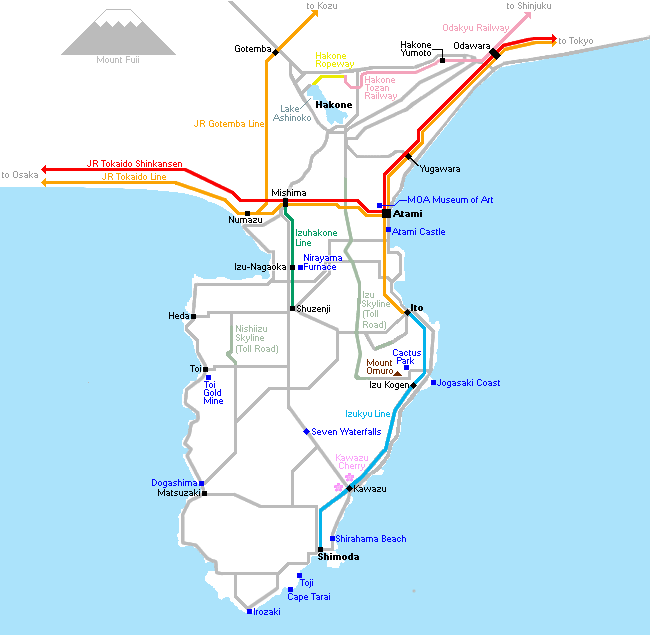 An area map of the Izu Peninsula and surrounding areas
An area map of the Izu Peninsula and surrounding areas
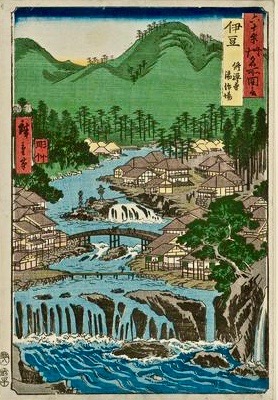 A 19th century woodblock print of Shuzenji from the '60 famous areas' series.
Clear mountain streams, vermilion-coloured bridges, sloping town streets, wooden town buildings, and late 19th century incorporations as cities can all symbolize the similarities of the two interesting communities of Nelson, B.C. and Shuzenji, Shizuoka Prefecture, Japan. In 2004, Shuzenji merged with three neighbouring towns, one of which was Naka Izu, which also had had a sister-city agreement with Hope, B.C. As a result, the then newly formed Izu City became sister-city to both Nelson and Hope, British Columbia. 2017 marks the 30th anniversary of the Nelson-Shuzenji agreement and official delegations from both places made trips across the Pacific Ocean to celebrate the occasion earlier this year.
A 19th century woodblock print of Shuzenji from the '60 famous areas' series.
Clear mountain streams, vermilion-coloured bridges, sloping town streets, wooden town buildings, and late 19th century incorporations as cities can all symbolize the similarities of the two interesting communities of Nelson, B.C. and Shuzenji, Shizuoka Prefecture, Japan. In 2004, Shuzenji merged with three neighbouring towns, one of which was Naka Izu, which also had had a sister-city agreement with Hope, B.C. As a result, the then newly formed Izu City became sister-city to both Nelson and Hope, British Columbia. 2017 marks the 30th anniversary of the Nelson-Shuzenji agreement and official delegations from both places made trips across the Pacific Ocean to celebrate the occasion earlier this year.
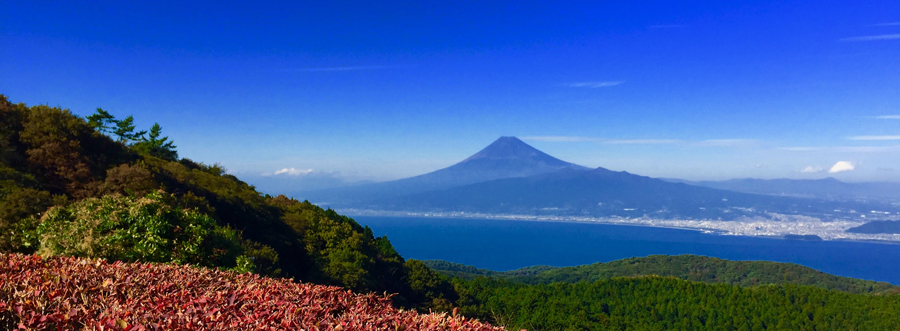 A view of Mount Fuji, 3776 metres high.
On Mt. Daruma, high above the west of Shuzenji (the name which I will use as one of the districts of Izu City from here onwards), there is a splendid view of Mt. Fuji and Suruga Bay. This picture was taken on November 1st, but unfortunately there was no snowcap to accentuate the summit.
A view of Mount Fuji, 3776 metres high.
On Mt. Daruma, high above the west of Shuzenji (the name which I will use as one of the districts of Izu City from here onwards), there is a splendid view of Mt. Fuji and Suruga Bay. This picture was taken on November 1st, but unfortunately there was no snowcap to accentuate the summit.
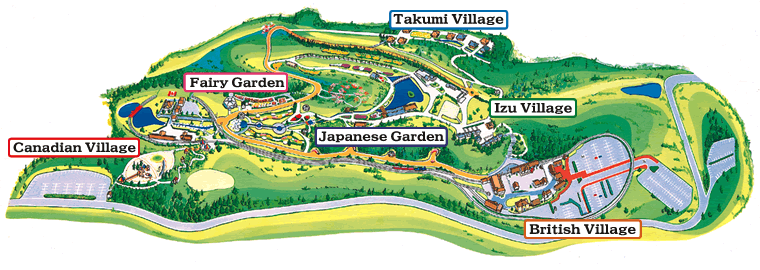 A map showing Niji no Sato, a large park in Shuzenji featuring flowers, domestic, and foreign attractions.
Just a little down the mountain from the viewpoint is an attraction called Niji no Sato. It features British and Canadian areas, a Japanese garden, and 2 Japanese village areas. The various areas are served by a 15-inch gauge railway modeled after the Romney, Hythe, and Dymchurch Railway in England. 4 or 5 different steam or diesel engines are featured in the railway museum / trainyard and actually carry the visitors around. The steam engine pictured in this picture is the Northern Rock II. The whole park was much too large to see in just 2 hours, so we spent most of the time taking in 'Nelson', and then walking back to the British village through part of the garden area.
A map showing Niji no Sato, a large park in Shuzenji featuring flowers, domestic, and foreign attractions.
Just a little down the mountain from the viewpoint is an attraction called Niji no Sato. It features British and Canadian areas, a Japanese garden, and 2 Japanese village areas. The various areas are served by a 15-inch gauge railway modeled after the Romney, Hythe, and Dymchurch Railway in England. 4 or 5 different steam or diesel engines are featured in the railway museum / trainyard and actually carry the visitors around. The steam engine pictured in this picture is the Northern Rock II. The whole park was much too large to see in just 2 hours, so we spent most of the time taking in 'Nelson', and then walking back to the British village through part of the garden area.
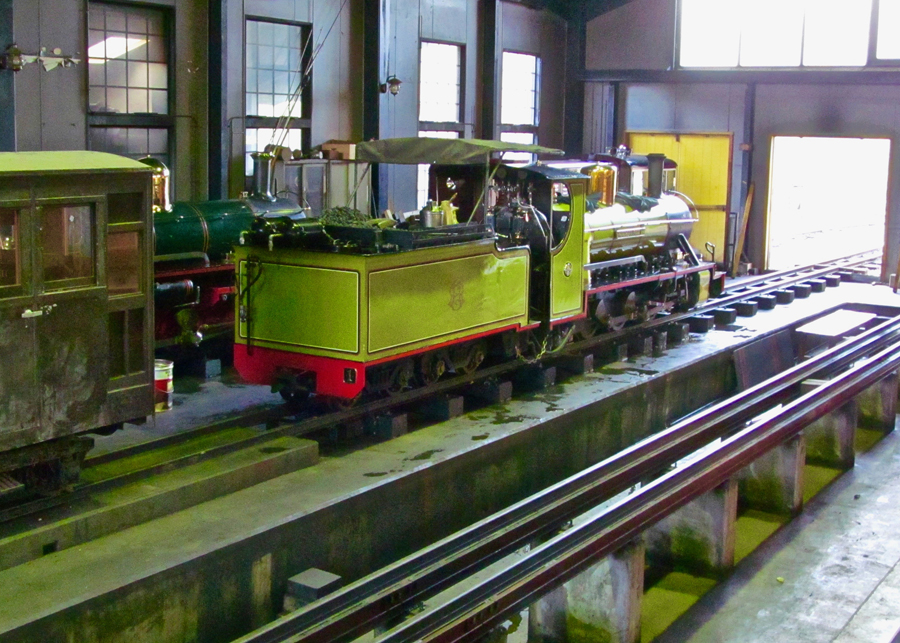 The 15" gauge British steam engine named the Northern Rock II
The 15" gauge British steam engine named the Northern Rock II
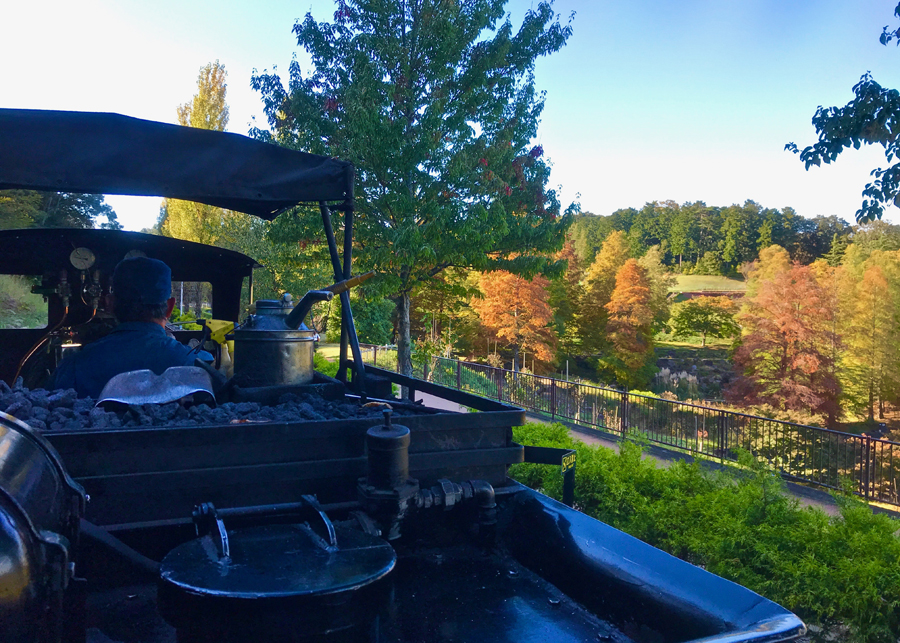 A view from the train on its way from the British village to Nelson Station.
A view from the train on its way from the British village to Nelson Station.
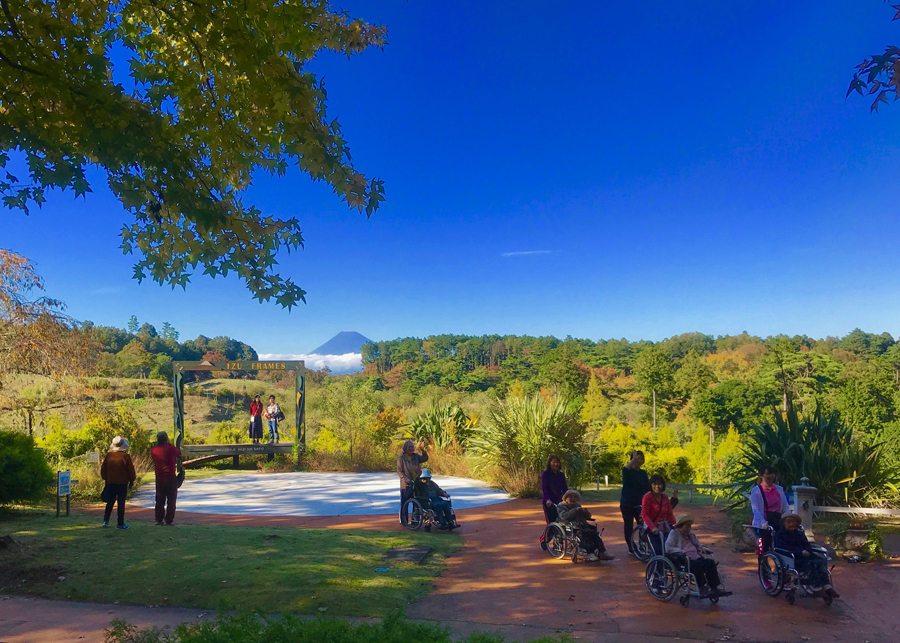 A view from the train as it moved past the 'Fuji Frame' viewpoint. Visitors who wish to have a framed Mt. Fuji in their photo can pose here. There is a deep valley just behind the frame, where different flowers bloom throughout most of the year.
A view from the train as it moved past the 'Fuji Frame' viewpoint. Visitors who wish to have a framed Mt. Fuji in their photo can pose here. There is a deep valley just behind the frame, where different flowers bloom throughout most of the year.
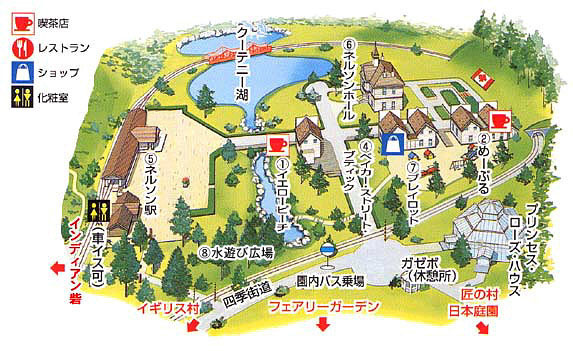 A map showing the layout of 'Nelson' with the station at the bottom, a symbolic Kootenay lake and the orange Nelson Bridge on the left, and a main street in the middle.
A map showing the layout of 'Nelson' with the station at the bottom, a symbolic Kootenay lake and the orange Nelson Bridge on the left, and a main street in the middle.
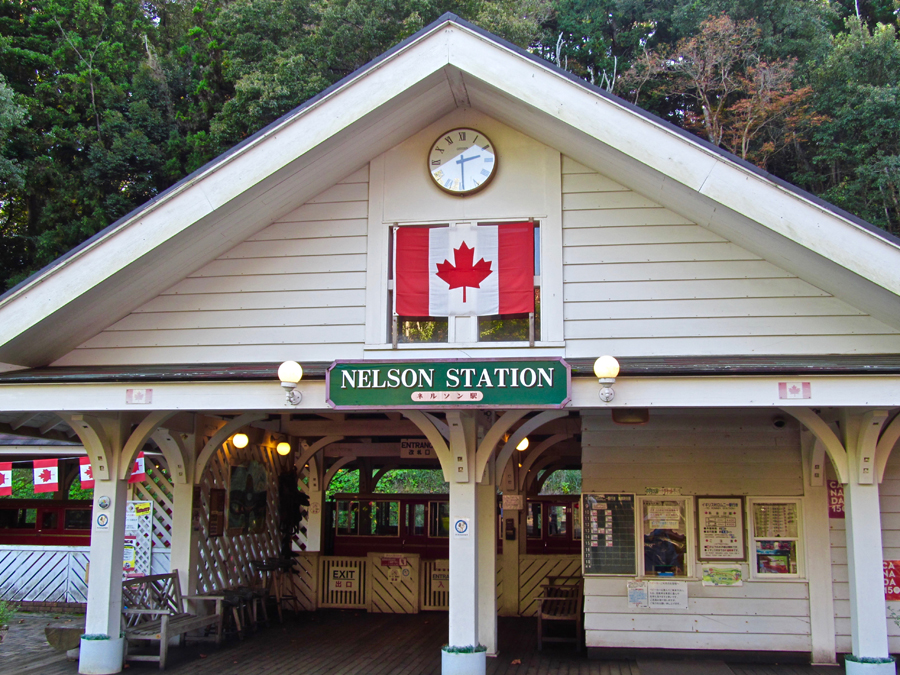 A view of 'Nelson' Station - many flags were out in honour of the 150th anniversary.
A view of 'Nelson' Station - many flags were out in honour of the 150th anniversary.
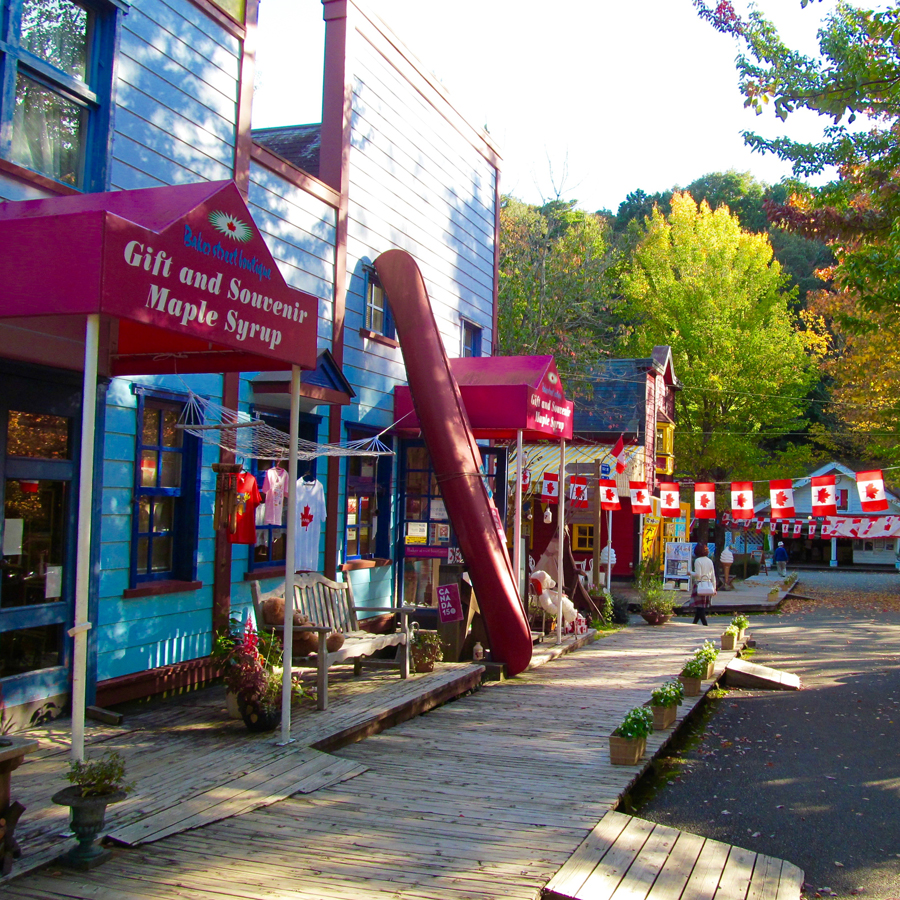 Part of the main street area - souvenirs and food were available
Part of the main street area - souvenirs and food were available
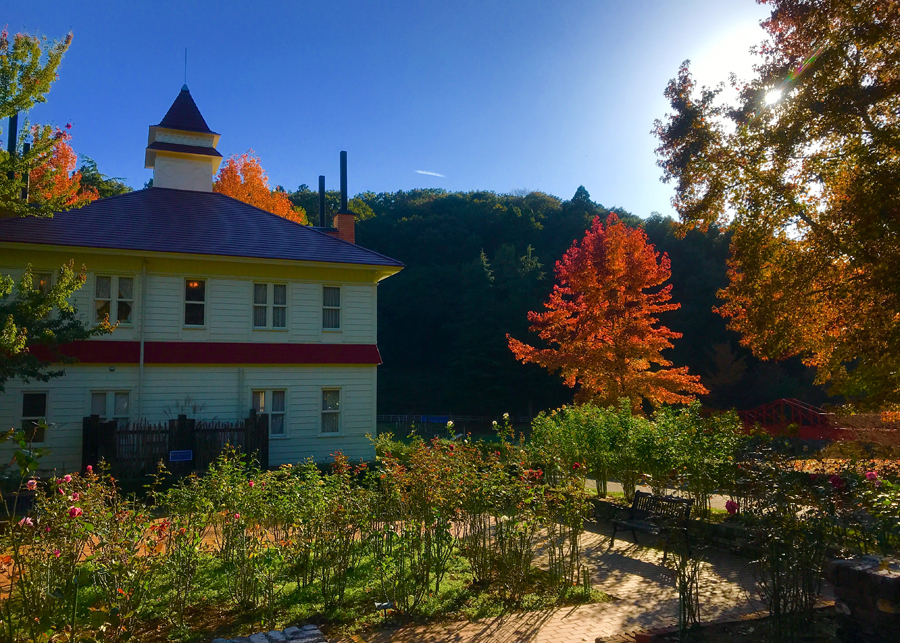 A view of 'Nelson Hall' from the rear. Inside featured the history of the Nelson/Hope/Shuzenji sister city agreements and products from Nelson and Hope. Being November, the rose garden in front was largely finished. Note the orange bridge in the shadows on the right. The original opened in 1957 and is 631 metres long.
A view of 'Nelson Hall' from the rear. Inside featured the history of the Nelson/Hope/Shuzenji sister city agreements and products from Nelson and Hope. Being November, the rose garden in front was largely finished. Note the orange bridge in the shadows on the right. The original opened in 1957 and is 631 metres long.
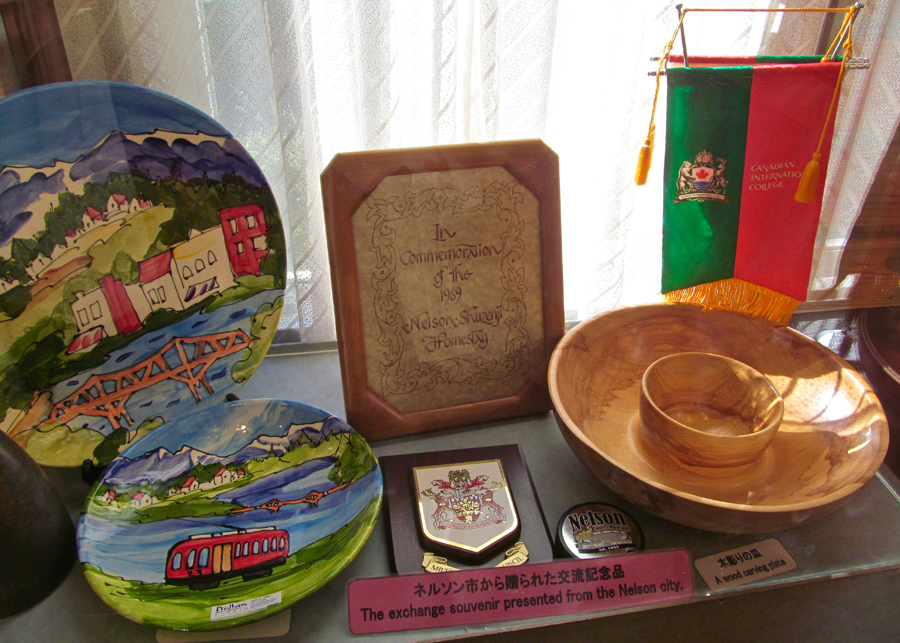 Various exchange items from a Nelson group. Local cedar wood carvings are also popular souvenirs here.
Various exchange items from a Nelson group. Local cedar wood carvings are also popular souvenirs here.
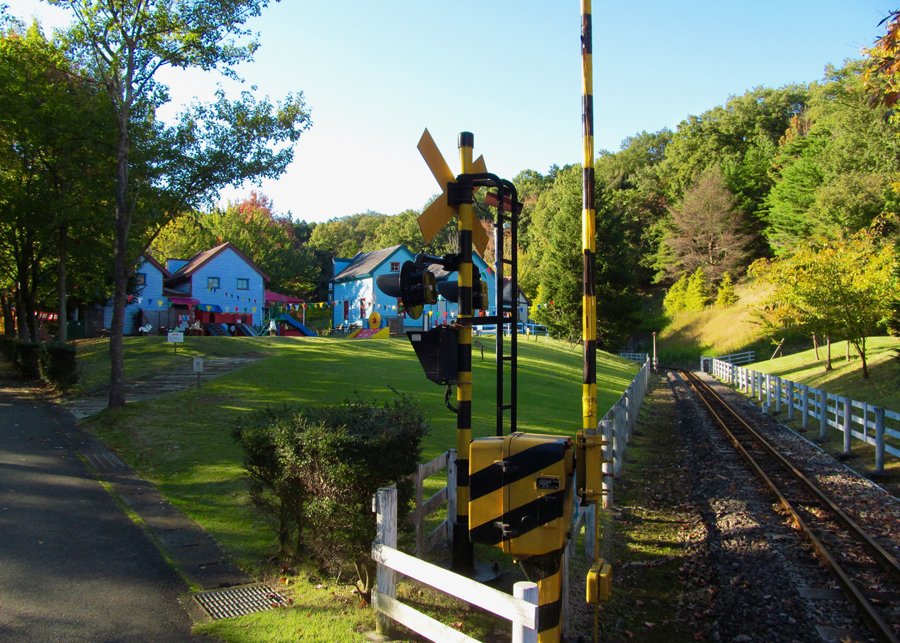 The area behind the Nelson stores showing a playground and the 15" gauge railway tracks.
The area behind the Nelson stores showing a playground and the 15" gauge railway tracks.
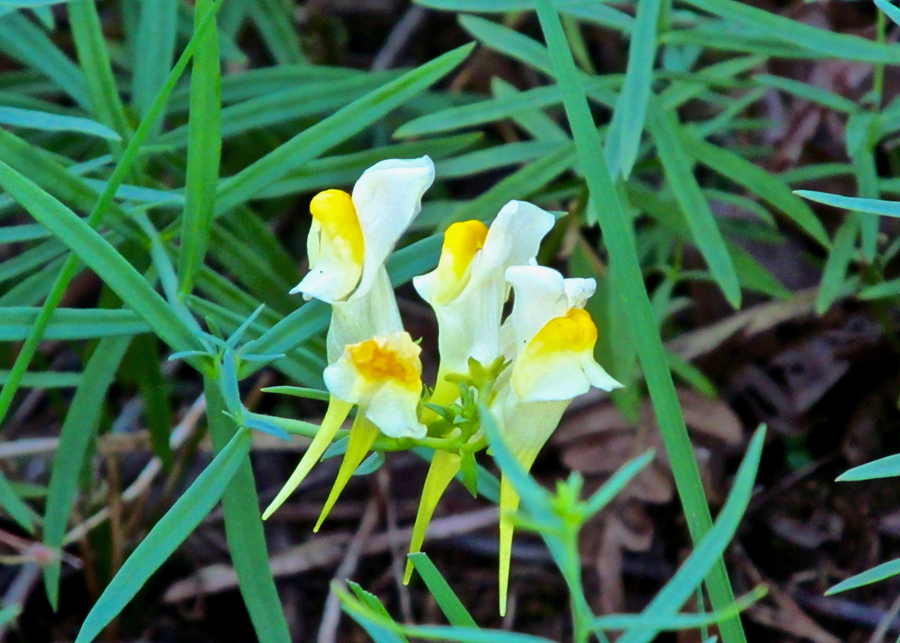 One part of the garden area is called 'the Fairy Gardens'. It is only this person's assumption, but if you look closely, you may imagine the face, wings, body and two legs of a fairy. These blossoms are only about 3 centimetres high.
One part of the garden area is called 'the Fairy Gardens'. It is only this person's assumption, but if you look closely, you may imagine the face, wings, body and two legs of a fairy. These blossoms are only about 3 centimetres high.
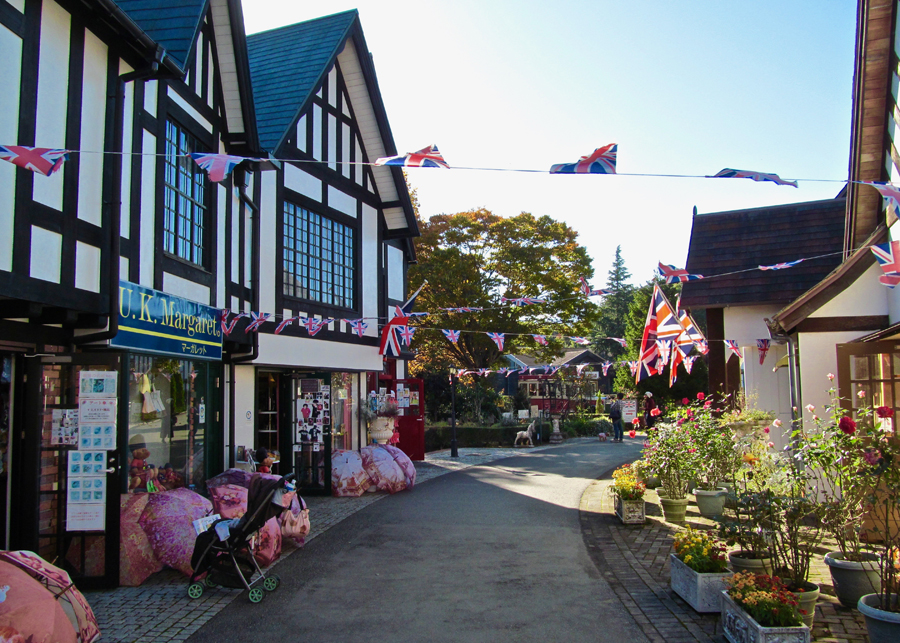 The 'British village' area, featuring souvenir shops, restaurants, and various cultural displays.
The 'British village' area, featuring souvenir shops, restaurants, and various cultural displays.
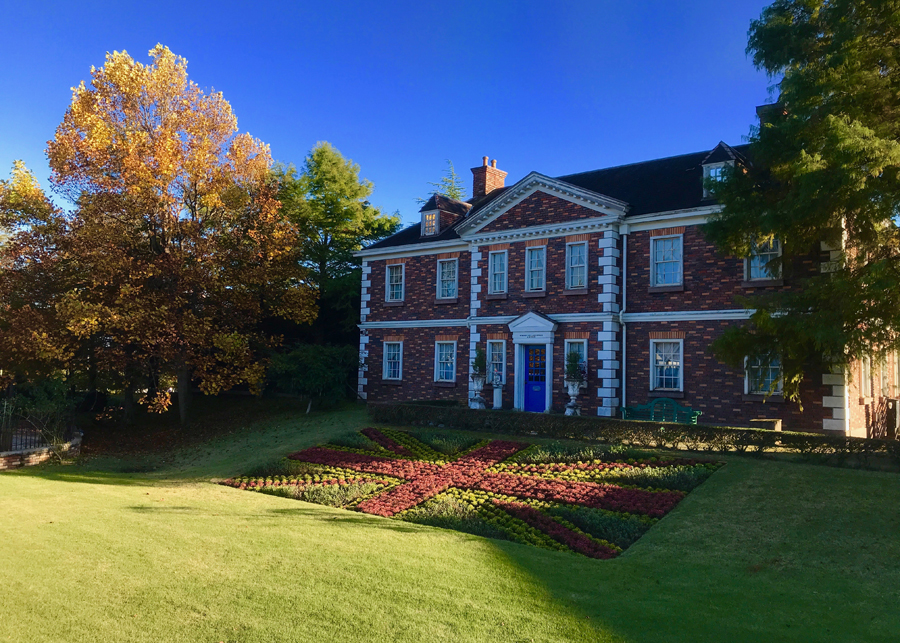 A British manor with flower flag.
We reached the compact 'downtown' area of the city the next morning before the probable caravan of tour buses arrived with day visitors. The main area for sightseeing can be covered in 60 - 90 minutes and a walking tour is the best way to see the sights. Signs are usually posted in Japanese, English, Chinese, and Korean, so it is easy to get around.
A British manor with flower flag.
We reached the compact 'downtown' area of the city the next morning before the probable caravan of tour buses arrived with day visitors. The main area for sightseeing can be covered in 60 - 90 minutes and a walking tour is the best way to see the sights. Signs are usually posted in Japanese, English, Chinese, and Korean, so it is easy to get around.
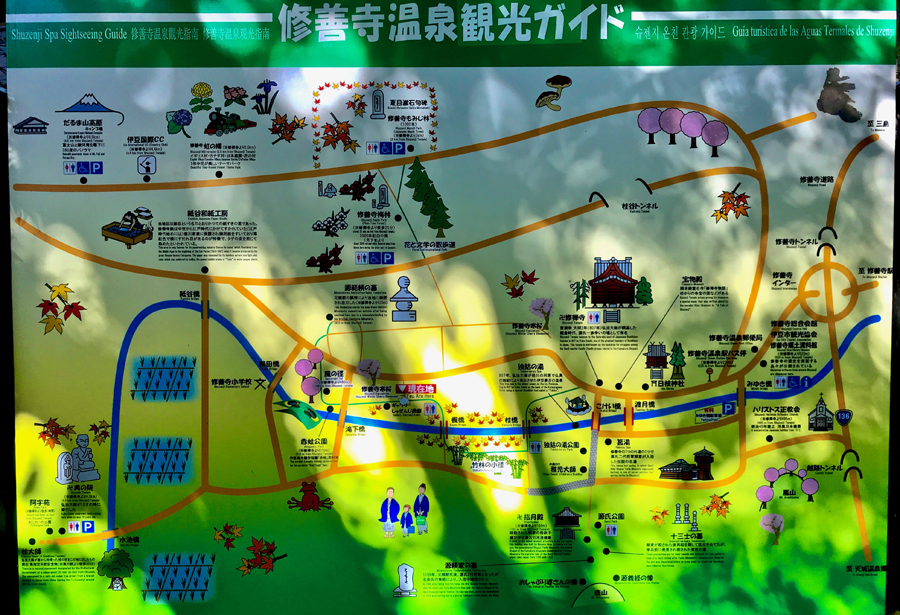 A sightseeing map of 'downtown' Shuzenji. Note the Katsura River going through the centre of town.
A sightseeing map of 'downtown' Shuzenji. Note the Katsura River going through the centre of town.
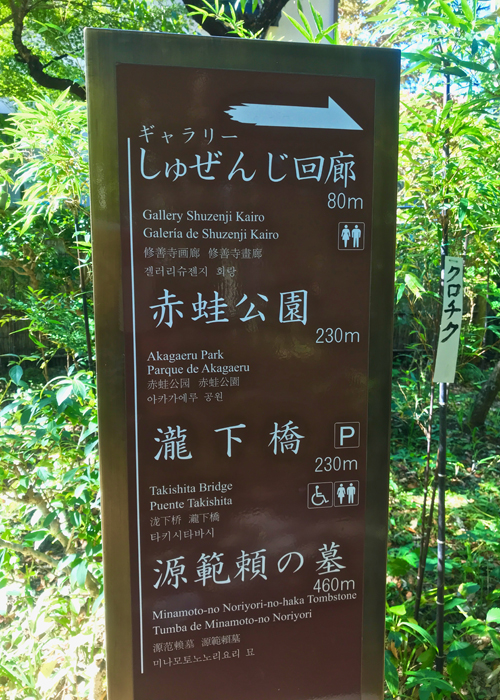 A signboard showing multiple language guides.
Many people will start at the namesake of the town, Shuzenji Temple, which was founded about 1,200 years ago by a monk called Kobo Daishi, one of Japan's most prominent religious figures. The legend goes that Kobo Daishi noticed some children playing in the cold river water, so he hit a rock in the river with his walking stick (a 'tokko') and out gushed hot water. It was called Tokko Hot Springs and the birthplace of Shuzenji Town. The present temple buildings are about 100 years old and are rather ordinary, but the temple's bell is superb.
A signboard showing multiple language guides.
Many people will start at the namesake of the town, Shuzenji Temple, which was founded about 1,200 years ago by a monk called Kobo Daishi, one of Japan's most prominent religious figures. The legend goes that Kobo Daishi noticed some children playing in the cold river water, so he hit a rock in the river with his walking stick (a 'tokko') and out gushed hot water. It was called Tokko Hot Springs and the birthplace of Shuzenji Town. The present temple buildings are about 100 years old and are rather ordinary, but the temple's bell is superb.
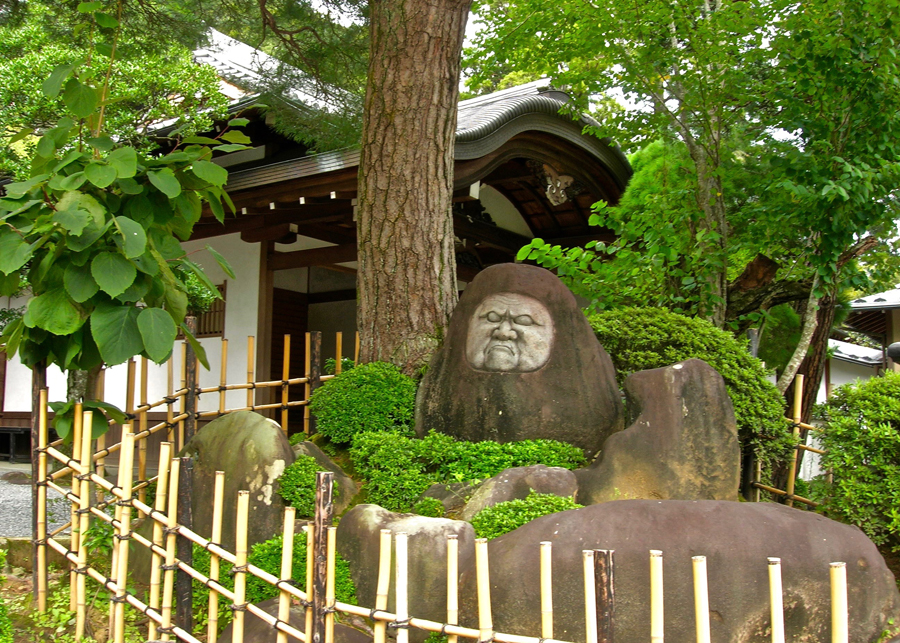 A rock carving in front of Shuzenji Temple's front area. Unfortunately, the main building was undergoing repairs and was covered with blue tarps.
A rock carving in front of Shuzenji Temple's front area. Unfortunately, the main building was undergoing repairs and was covered with blue tarps.
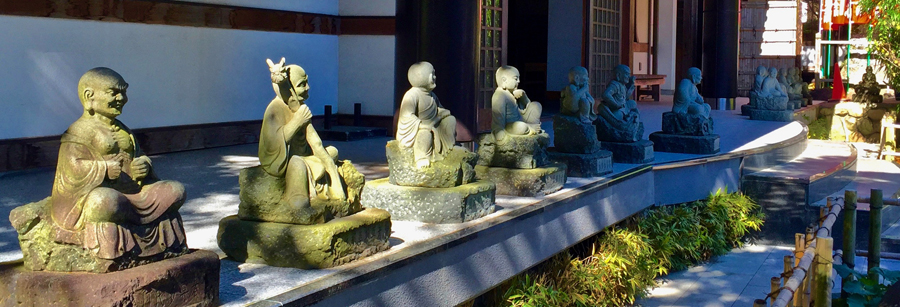 Some small stone Buddhas (Buddhist) alongside one of the buildings.
Some small stone Buddhas (Buddhist) alongside one of the buildings.
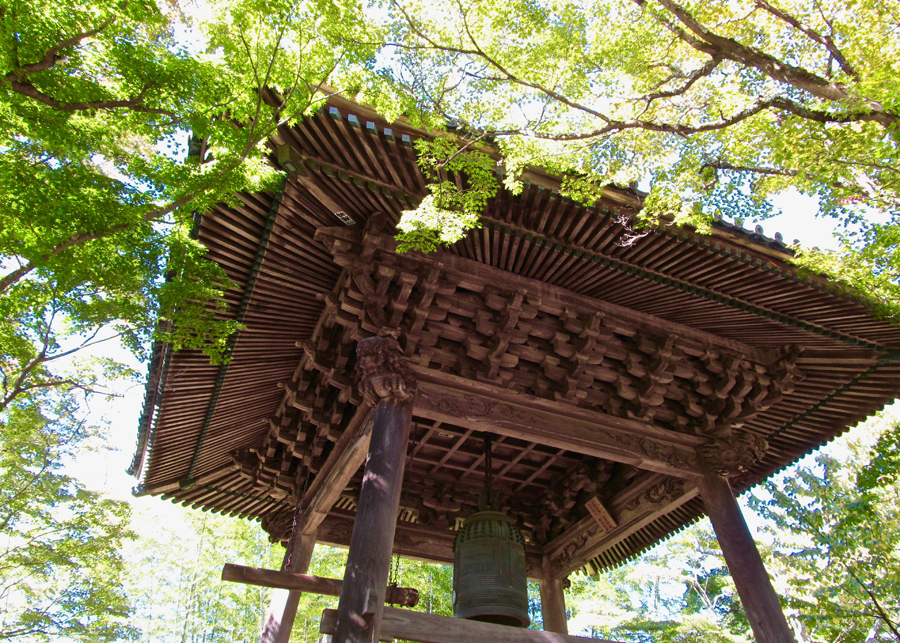 The aforementioned main bell building - think of the worksmanship required to hold up such a heavy bell without 'nails' as such.
The aforementioned main bell building - think of the worksmanship required to hold up such a heavy bell without 'nails' as such.
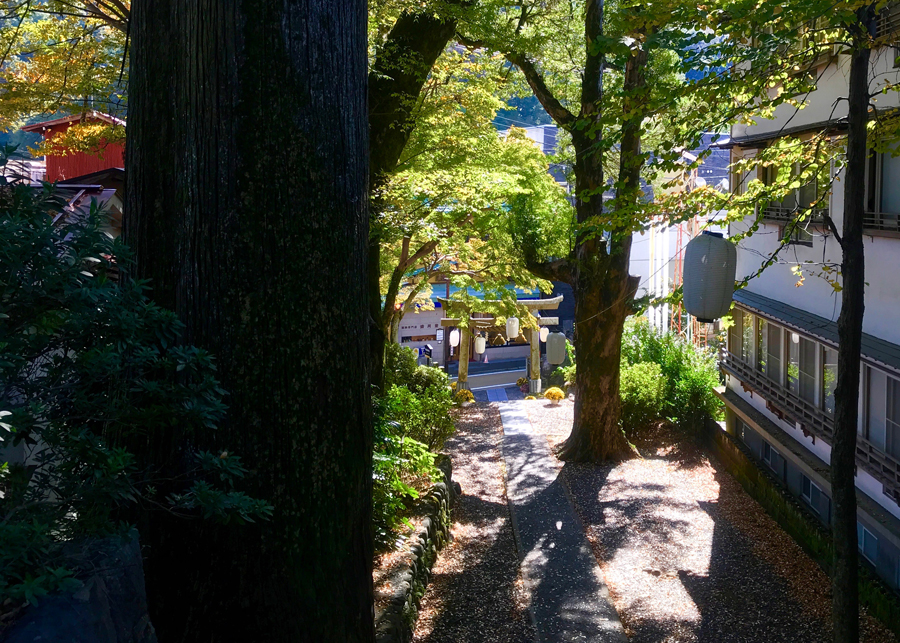 There is little flat land in Shuzenji, and another nearby shrine (Shintoist) for making / keeping couples stay together features a steeply sloped approach.
There is little flat land in Shuzenji, and another nearby shrine (Shintoist) for making / keeping couples stay together features a steeply sloped approach.
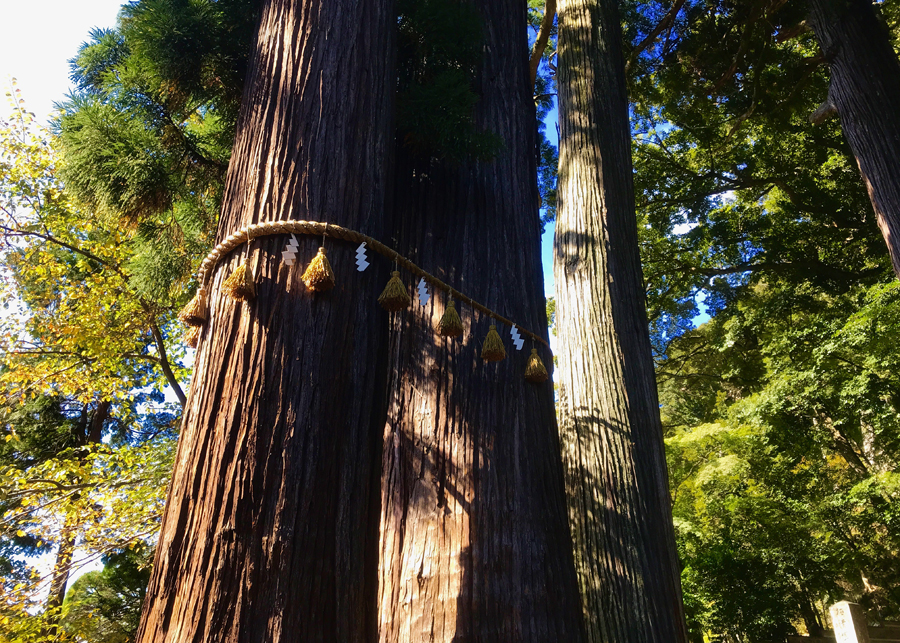 A symbolic coupling of the cedar trees with rope and purification papers. There is a small praying altar at the base of the trees.
A symbolic coupling of the cedar trees with rope and purification papers. There is a small praying altar at the base of the trees.
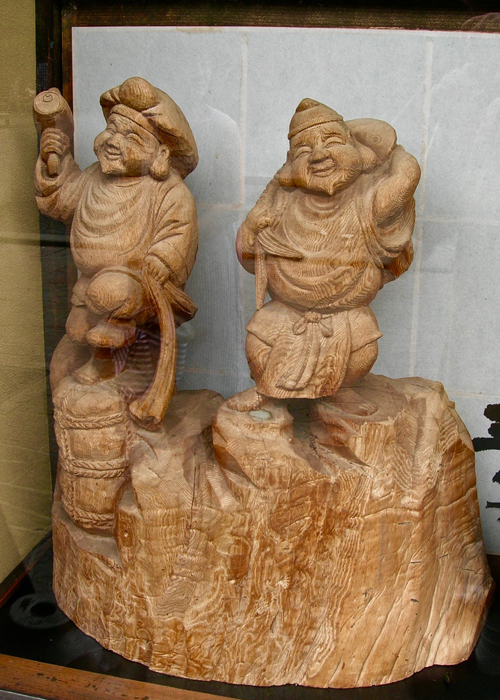 A large cedar wood carving of two 'lucky characters' in a store window. Many other wonderful carvings were inside the stores, but they didn't allow photos to be taken.
Right in front of Shuzenji Temple is the Katsura River, lined by many inns on both sides and linked by 5 or 6 vermilion-coloured bridges. There is a free hot spring footbath for weary walkers and past this area, a well-marked walking course leads up the river to a large bamboo grove on the other side. This is the most beautiful area.
A large cedar wood carving of two 'lucky characters' in a store window. Many other wonderful carvings were inside the stores, but they didn't allow photos to be taken.
Right in front of Shuzenji Temple is the Katsura River, lined by many inns on both sides and linked by 5 or 6 vermilion-coloured bridges. There is a free hot spring footbath for weary walkers and past this area, a well-marked walking course leads up the river to a large bamboo grove on the other side. This is the most beautiful area.
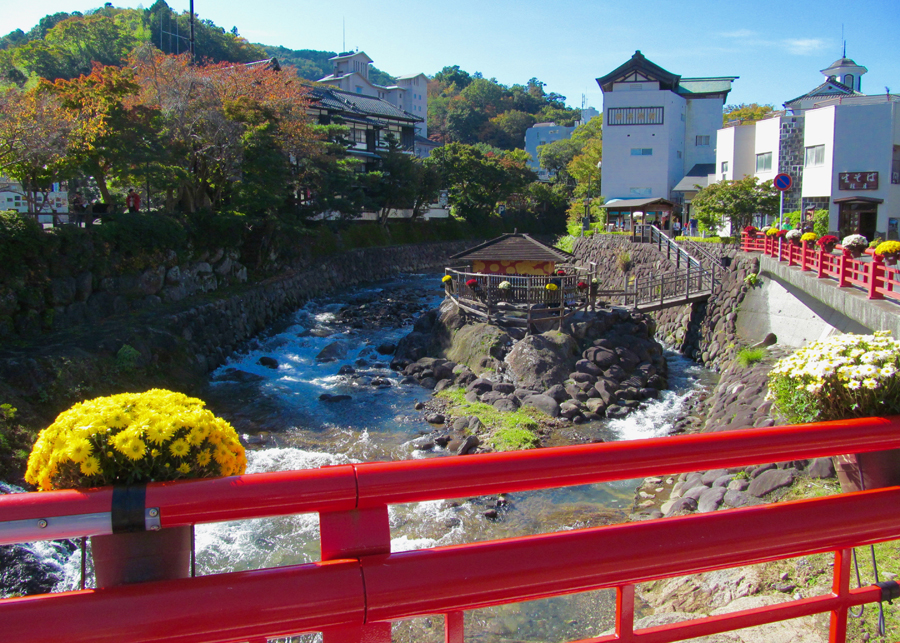 In front of Shuzenji Temple, showing one footbath under the gazebo in the middle of the river and another one allowing easier access to the right, just above where the stairs lead down. The walking tour starts from there.
In front of Shuzenji Temple, showing one footbath under the gazebo in the middle of the river and another one allowing easier access to the right, just above where the stairs lead down. The walking tour starts from there.
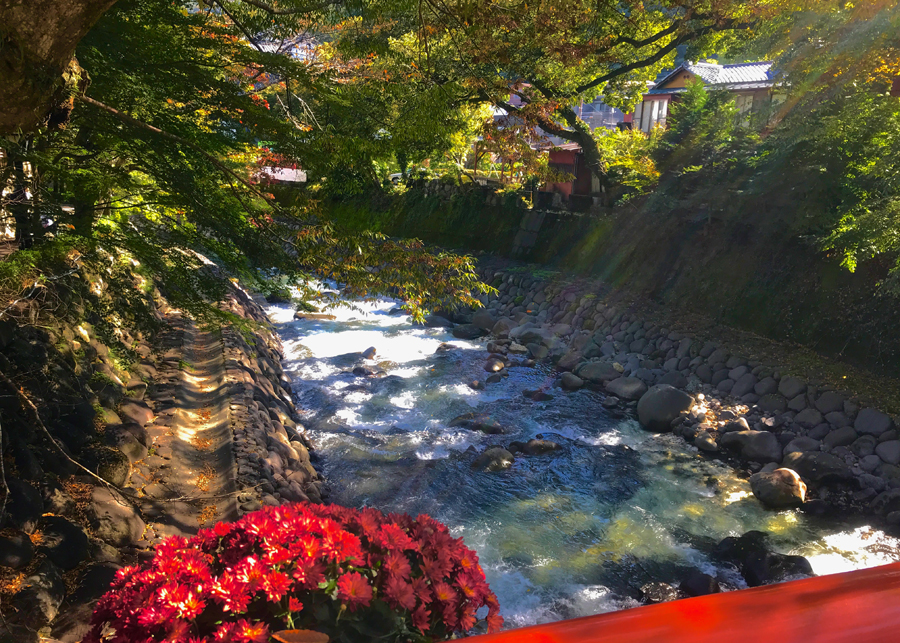 Suddenly it seems that you are in a forest with a rushing stream right in front of you. The red leaves at the end of November must be beautiful.
Suddenly it seems that you are in a forest with a rushing stream right in front of you. The red leaves at the end of November must be beautiful.
 Eventually you cross one of the river bridges which leads you into a bamboo forest reminiscent of western Kyoto. There is a central circular rest area to sit and view the tall bamboo. Various bamboo products are souvenir items, along with cedar carvings, and for the kitchen cook, Japanese horseradish, black rice, and mushrooms are featured local products.
These are the highlight areas, but just as interesting are the views as you reverse your way down the other mountainside. This side has many inns, old shops, and narrow roads to explore.
Eventually you cross one of the river bridges which leads you into a bamboo forest reminiscent of western Kyoto. There is a central circular rest area to sit and view the tall bamboo. Various bamboo products are souvenir items, along with cedar carvings, and for the kitchen cook, Japanese horseradish, black rice, and mushrooms are featured local products.
These are the highlight areas, but just as interesting are the views as you reverse your way down the other mountainside. This side has many inns, old shops, and narrow roads to explore.
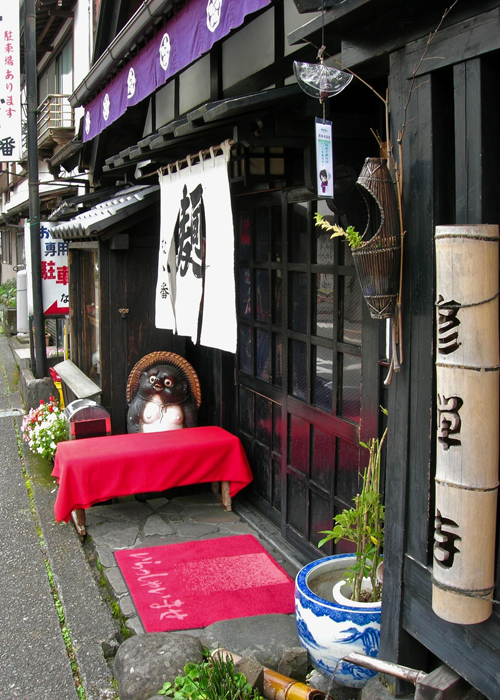 A reasonably-priced restaurant featuring a raccoon dog in front. I didn't notice any McDonald's or other modern-looking chain restaurants in this area.
A reasonably-priced restaurant featuring a raccoon dog in front. I didn't notice any McDonald's or other modern-looking chain restaurants in this area.
 This is a cedar woodcarving on the front entrance of a Japanese inn. Depending on your pocketbook and amenities, prices run from reasonable to extravagant.
This is a cedar woodcarving on the front entrance of a Japanese inn. Depending on your pocketbook and amenities, prices run from reasonable to extravagant.
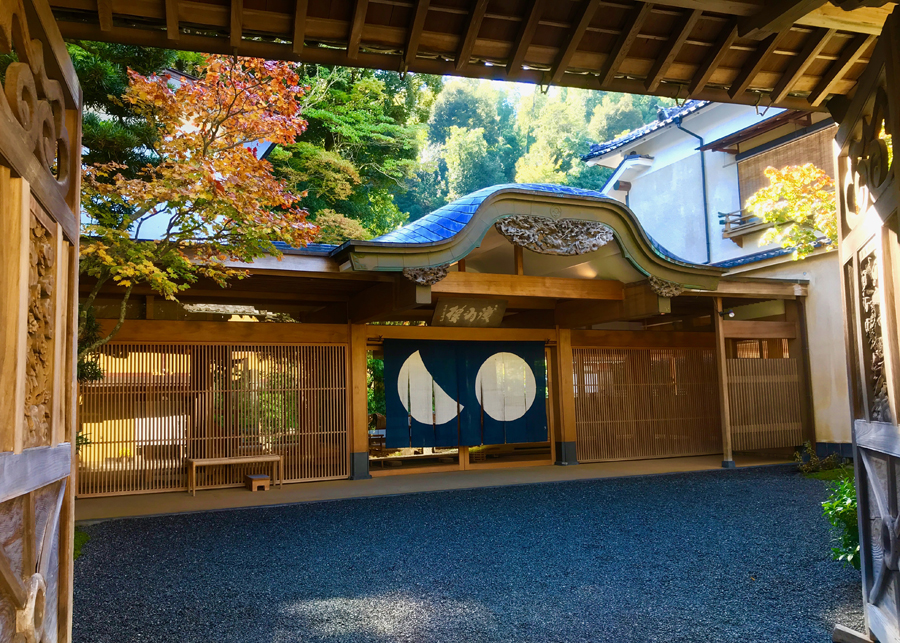 This would be a high end stay. Most inns provide a Japanese-style room with two meals as the standard plan.
This would be a high end stay. Most inns provide a Japanese-style room with two meals as the standard plan.
 While a large open-air bath is hoped for by most Japanese, an in-room hot spring bath is also very popular. It can be used at anytime, the water temperature can be adjusted to one's likes, it is private, and you can often have a nice view outside. Our bath, made of cypress wood, had a good-sized open room next to it with a sofa and table for snacking and a view of Mt. Fuji. It was about $300 a night including breakfasts for three.
While a large open-air bath is hoped for by most Japanese, an in-room hot spring bath is also very popular. It can be used at anytime, the water temperature can be adjusted to one's likes, it is private, and you can often have a nice view outside. Our bath, made of cypress wood, had a good-sized open room next to it with a sofa and table for snacking and a view of Mt. Fuji. It was about $300 a night including breakfasts for three.
 A reasonably-priced Japanese restaurant.
A reasonably-priced Japanese restaurant.
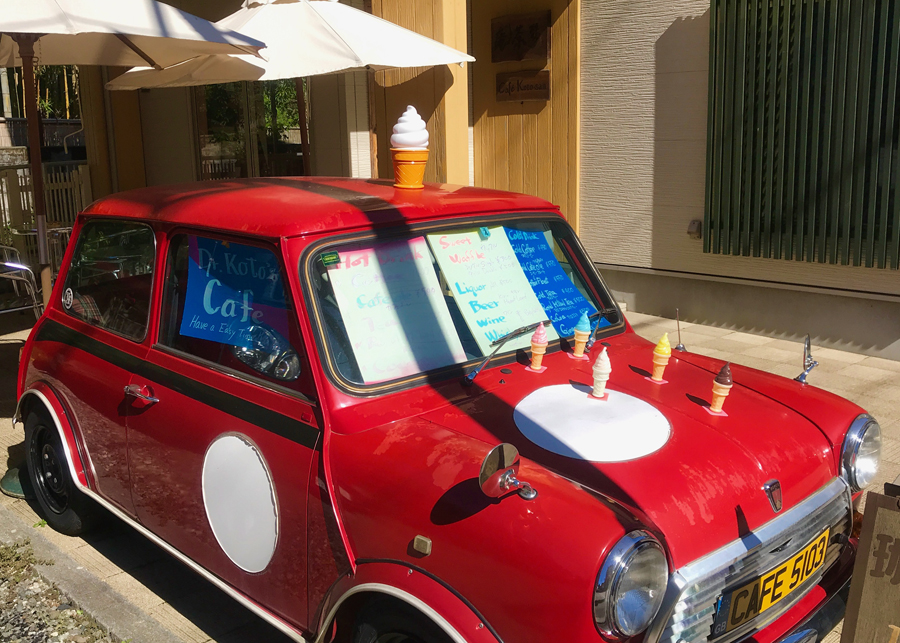 Anything to sell ice cream cones! But even in early November it was still warm, so we succumbed to the temptation.
Anything to sell ice cream cones! But even in early November it was still warm, so we succumbed to the temptation.
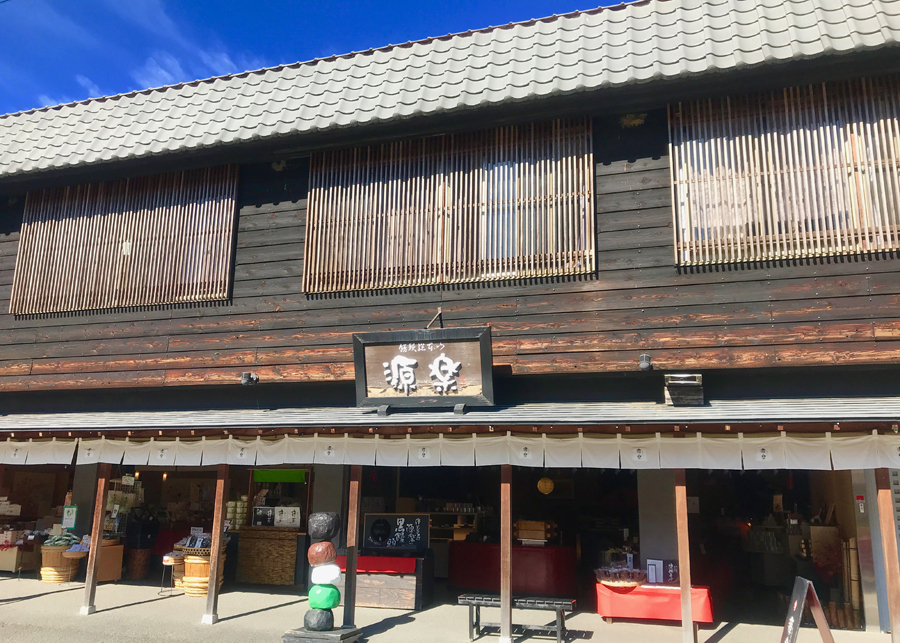 A famous, old-style Japanese souvenir store next to the temple - they didn't use curtains inside the windows, so the wooden slats provided some measure of privacy and security.
A famous, old-style Japanese souvenir store next to the temple - they didn't use curtains inside the windows, so the wooden slats provided some measure of privacy and security.
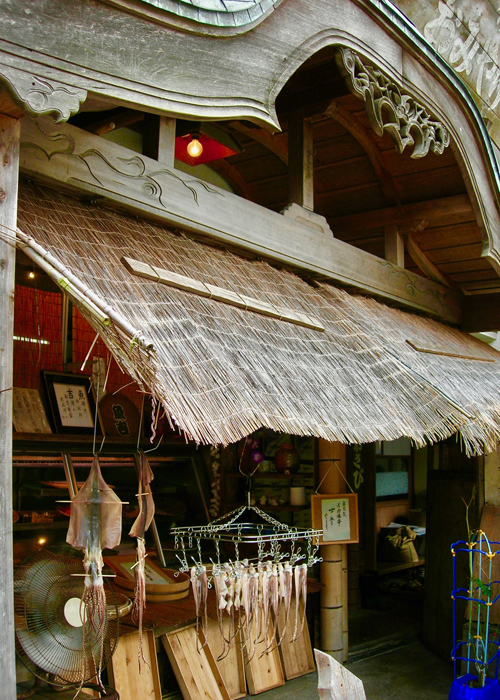 A curious souvenir store. I'm not sure exactly what it specialized in. Those are drying squid out front on the left, but in the dark interior I saw pottery and wood products amidst a mishmash of other 'stuff'. My interest was in the wood used in the ornamentation, and it was of wonderful workmanship.
All in all, Nelson / Hope, and the Shuzenji District of Izu City seem to be excellent matches for each other. I've neglected various things due to space constraint, so if interested, please access further information online.
A curious souvenir store. I'm not sure exactly what it specialized in. Those are drying squid out front on the left, but in the dark interior I saw pottery and wood products amidst a mishmash of other 'stuff'. My interest was in the wood used in the ornamentation, and it was of wonderful workmanship.
All in all, Nelson / Hope, and the Shuzenji District of Izu City seem to be excellent matches for each other. I've neglected various things due to space constraint, so if interested, please access further information online.
|
|
Visit us on eBay and Facebook
|
|
We also have an eBay auction site and store: http://www.ebay.ca/usr/weedastamps
Visit Weeda Stamps on Facebook: https://www.facebook.com/weedastampsltd/
|
|
Answer to Last Week's Salvation Army Quiz
|
|
We received six correct answers to our last stamp identification quiz. That means a $6.00 donation to Salvation Army.
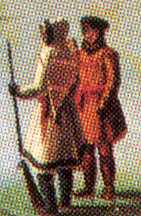 Here's the portion of the stamp we asked you to identify
Here's the portion of the stamp we asked you to identify
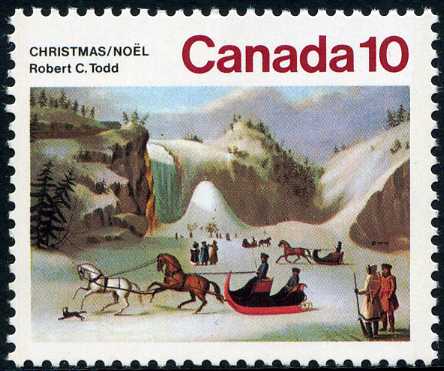 Here's the answer - Canada #652, 10c "The Ice Cone", one of the Christmas issues of 1974.
Here's the answer - Canada #652, 10c "The Ice Cone", one of the Christmas issues of 1974.
|
|
The Salvation Army Quiz
|
|
We show you a minute portion of the design of a postage stamp. You have to determine which stamp it is. Send us an email with your answer.

We hold a contest almost every newsletter. For every correct answer we will donate $1.00 to our favourite charity, the Salvation Army. Click here to go to the The Salvation Army International Home Page to see what services they offer to communities around the world.
|
Our Current Newsletter
Edition #650
Tuesday, April 14, 2020
Recent Newsletters
|
Edition #649 Thursday, May 2, 2019
Along the E&N: A Journey Back to the Historic Hotels of Vancouver Island by Glen A. Mofford
|
Edition #648 Thursday, March 28, 2019
The Elusive Fifty
|
Edition #647 Monday, February 25, 2019
Please Use Our New Address!
|
Edition #646 Thursday, September 27, 2018
The Latest News
|
Edition #645 Friday, May 11, 2018
Canstruction 2018
|
Edition #644 Friday, April 20, 2018
Ed in Ottawa and His Stamp Collages
|
Edition #643 Friday, March 30, 2018
The one-cent King Edward re-entry and Victoriana collection
|
Edition #642 Friday, February 16, 2018
Victoria's Baker's Club First Meeting at 811 Princess Avenue
|
|